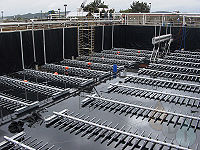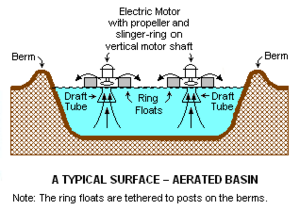Aeration basin: Difference between revisions
imported>Milton Beychok m (→Floating surface aerators: Added a phrase) |
mNo edit summary |
||
| (One intermediate revision by one other user not shown) | |||
| Line 1: | Line 1: | ||
{{subpages}} | {{subpages}} | ||
{{Image|Aeration Basin.jpg|right|200px|Aeration basin using a submerged grid of air diffusers.}} | |||
An '''aeration basin''' (also called an '''aeration lagoon''') is a holding and/or treatment [[pond]] provided with artificial [[aeration]] to promote the biochemical [[oxidation]] of [[wastewater]]s.<ref>{{cite book |author=Middlebrooks, E.J., et al.|title=Wastewater Stabilization Lagoon Design, Performance and Upgrading|edition= |publisher=McMillan Publishing| year=1982|isbn=0-02-949500-8}}</ref><ref>{{cite book|author=Tchobanoglous, G., Burton, F.L., and Stensel, H.D.|title=Wastewater Engineering (Treatment Disposal Reuse) / Metcalf & Eddy, Inc.|edition=4th|publisher=McGraw-Hill Book Company|year=2003|isbn=0-07-041878-0}}</ref><ref>{{cite book | author=Beychok, Milton R. | title=[[Aqueous Wastes from Petroleum and Petrochemical Plants]] | edition=1st | publisher=John Wiley & Sons | year=1967 | id= [[LCCN]] 67019834}}</ref> There are many other biological processes for treatment of wastewaters, for example the [[activated sludge process]], [[trickling filter]]s (also called biofilters) and [[Trickling_filter#Types_of_large-scale_trickle_filters|rotating biological contactors]]. They all have in common the use of [[oxygen]] (or air) and [[Microbe|microbial]] action to biotreat the pollutants in wastewaters. | An '''aeration basin''' (also called an '''aeration lagoon''') is a holding and/or treatment [[pond]] provided with artificial [[aeration]] to promote the biochemical [[oxidation]] of [[wastewater]]s.<ref>{{cite book |author=Middlebrooks, E.J., et al.|title=Wastewater Stabilization Lagoon Design, Performance and Upgrading|edition= |publisher=McMillan Publishing| year=1982|isbn=0-02-949500-8}}</ref><ref>{{cite book|author=Tchobanoglous, G., Burton, F.L., and Stensel, H.D.|title=Wastewater Engineering (Treatment Disposal Reuse) / Metcalf & Eddy, Inc.|edition=4th|publisher=McGraw-Hill Book Company|year=2003|isbn=0-07-041878-0}}</ref><ref>{{cite book | author=Beychok, Milton R. | title=[[Aqueous Wastes from Petroleum and Petrochemical Plants]] | edition=1st | publisher=John Wiley & Sons | year=1967 | id= [[LCCN]] 67019834}}</ref> There are many other biological processes for treatment of wastewaters, for example the [[activated sludge process]], [[trickling filter]]s (also called biofilters) and [[Trickling_filter#Types_of_large-scale_trickle_filters|rotating biological contactors]]. They all have in common the use of [[oxygen]] (or air) and [[Microbe|microbial]] action to biotreat the pollutants in wastewaters. | ||
| Line 22: | Line 24: | ||
==References== | ==References== | ||
{{reflist}} | {{reflist}}[[Category:Suggestion Bot Tag]] | ||
Latest revision as of 16:01, 6 July 2024
An aeration basin (also called an aeration lagoon) is a holding and/or treatment pond provided with artificial aeration to promote the biochemical oxidation of wastewaters.[1][2][3] There are many other biological processes for treatment of wastewaters, for example the activated sludge process, trickling filters (also called biofilters) and rotating biological contactors. They all have in common the use of oxygen (or air) and microbial action to biotreat the pollutants in wastewaters.
Types of aerated basins
There are many methods for aerating a lagoon or basin:
- Motor-driven floating surface aerators
- Motor-driven submerged aerators
- Motor-driven fixed-in-place surface aerators
- Injection of compressed air through submerged diffusers
Floating surface aerators
Ponds or basins using floating surface aerators achieve 80 to 90% removal of BOD with retention times of 1 to 10 days.[4] The ponds or basins may range in depth from 1.5 to 5.0 metres.[4]
In a surface-aerated system, the aerators provide two functions: they transfer air into the basins required by the biological oxidation reactions, and they provide the mixing required for dispersing the air and for contacting the reactants (that is, oxygen, wastewater and microbes). Typically, the floating surface aerators are rated to deliver the amount of air equivalent to 1.8 to 2.7 kg O2/kWh. However, they do not provide as good mixing as is normally achieved in activated sludge processes and therefore aerated basins do not achieve the same performance level as activated sludge units.[4]
Biochemical oxidation processes are sensitive to temperature and, between 0 °C and 40 °C, the rate of biological reactions increases with temperature. Most surface aerated vessels operate at a temperature of between 4 °C and 32 °C.[4]
References
- ↑ Middlebrooks, E.J., et al. (1982). Wastewater Stabilization Lagoon Design, Performance and Upgrading. McMillan Publishing. ISBN 0-02-949500-8.
- ↑ Tchobanoglous, G., Burton, F.L., and Stensel, H.D. (2003). Wastewater Engineering (Treatment Disposal Reuse) / Metcalf & Eddy, Inc., 4th. McGraw-Hill Book Company. ISBN 0-07-041878-0.
- ↑ Beychok, Milton R. (1967). Aqueous Wastes from Petroleum and Petrochemical Plants, 1st. John Wiley & Sons. LCCN 67019834.
- ↑ 4.0 4.1 4.2 4.3 Beychok, M.R. (1971). "Performance of surface-aerated basins". Chemical Engineering Progress Symposium Series 67 (107): 322–339. Available at CSA Illumina website
- Pages using ISBN magic links
- CZ Live
- Biology Workgroup
- Chemistry Workgroup
- Engineering Workgroup
- Chemical Engineering Subgroup
- Environmental Engineering Subgroup
- Articles written in American English
- All Content
- Biology Content
- Chemistry Content
- Engineering Content
- Chemical Engineering tag
- Environmental Engineering tag

